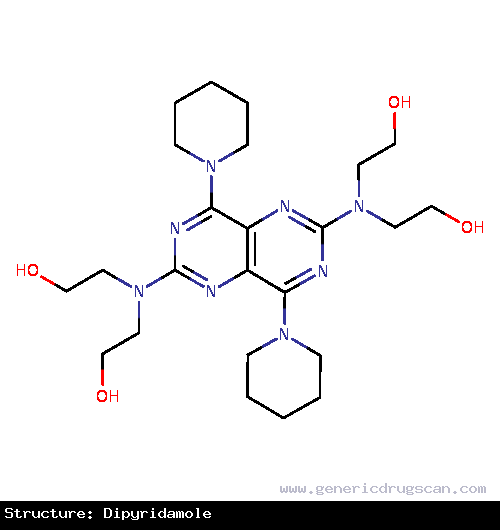Dipyridamole Drug: Indication, Dosage, Precaution, Side Effect , Storage, Category Type and corresponding Brands - www.genericdrugscan.com
Dipyridamole
Drug Status in USA : ApprovedDrug Status in Canada : Approved
pronunciation
pronounced as (dye peer id' a mole)
Why is this medication prescribed?
Dipyridamole is used with other drugs to reduce the risk of blood clots after heart valve replacement. It works by preventing excessive blood clotting.
How should this medicine be used?
Dipyridamole comes as a tablet to take by mouth. It is usually taken 4 times a day. Follow the directions on your prescription label carefully, and ask your doctor or pharmacist to explain any part you do not understand. Take dipyridamole exactly as directed. Do not take more or less of it or take it more often than prescribed by your doctor.
Continue to take dipyridamole even if you feel well. Do not stop taking dipyridamole without talking to your doctor.
What are the precautions to be followed?
Before taking dipyridamole,- tell your doctor and pharmacist if you are allergic to dipyridamole or any other drugs.
- tell your doctor and pharmacist what prescription and nonprescription medications you are taking, especially aspirin and vitamins.
- tell your doctor if you have or have ever had low blood pressure.
- tell your doctor if you are pregnant, plan to become pregnant, or are breast-feeding. If you become pregnant while taking dipyridamole, call your doctor.
- talk to your doctor about the risks and benefits of taking dipyridamole if you are 65 years of age or older. Older adults should not usually take dipyridamole because it is not as safe or effective as other medications that can be used to treat the same condition.
- if you are having surgery, including dental surgery, tell the doctor or dentist that you are taking dipyridamole.
What are possible side effects of this medication ?
Dipyridamole may cause side effects. Tell your doctor if any of these symptoms are severe or do not go away:- dizziness
- stomach pain
- headache
- rash
- diarrhea
- vomiting
- flushing (feeling of warmth)
- itching
- unusual bleeding or bruising
- yellowing of the skin or eyes
- chest pain
How to store the medication and dispose it of after its use later?
Keep this medication in the container it came in, tightly closed, and out of reach of children. Store it at room temperature and away from excess heat and moisture (not in the bathroom). Throw away any medication that is outdated or no longer needed. Talk to your pharmacist about the proper disposal of your medication.
Drug Category/Class
- Phosphodiesterase Inhibitors
- Platelet Aggregation Inhibitors
- Vasodilator Agents
- Platelet Aggregation Inhibitors Excl. Heparin
- Antithrombotic Agents
- Blood and Blood Forming Organs
- Platelet aggregation inhibitors excl. heparin
| Prescribed | For as an adjunct to coumarin anticoagulants in the prevention of postoperative thromboembolic complications of cardiac valve replacement and also ... |
| Weight : | 504.6256 |
| Structure | Dipyridamole |
 | |
| Formula | C24H40N8O4 |
Dipyridamole has 11 Brands listed
| Cardiwell (100 mg) | Cardiwell (25 mg) |
| Cardiwell (75 mg) | Deplatol (100 mg) |
| Deplatol (25 mg) | Dipyridamol (25 mg) |
| Dynacard (100 mg) | Persantin (100 mg) |
| Persantin (25 mg) | Thrombonil (100 mg) |
| Thrombonil (75 mg) |
Search Generic Drugs alphabetically
